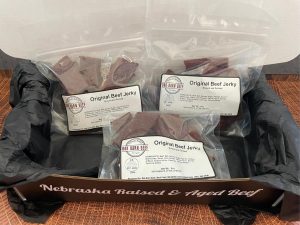How to Ensure the Tenderness of Your Beef Jerky Subscription?
How to Ensure the Tenderness of Your Beef Jerky Subscription?
A premium beef jerky subscription is the gift that keeps on giving. It is a delicious journey of flavor and a celebration of small-town artisans.
The secret to ensuring the tenderness of your jerky is in the preparation. Slicing meat against the grain helps to break down tough muscle fibers, and a light pounding with a meat tenderizer before marinating increases softness.
Marination
The marination process is an integral step in making beef jerky. It infuses the meat with flavor, tenderizes it by breaking down proteins, and helps preserve the jerky by creating an inhospitable environment for bacteria and controlling moisture to ensure even drying.
A well-made marinade also adds a delicious savory, spicy or herby kick to the finished product. Marinades can vary from simple salt and pepper concoctions to complex mixes containing spices, herbs, vinegar or citrus juices. This versatility makes it possible to offer a wide variety of flavors, dietary accommodations, and safety considerations.
The ideal marination time for beef jerky is anywhere from 8-36 hours. This allows the acidic components of the marinade to break down the muscle proteins that make jerky tough, turning them into a more palatable and chewable consistency. It also gives the marinade plenty of time to penetrate into the pores of each piece of meat, infusing it with rich flavors and ensuring that all areas are equally coated with the desired ingredients.
Seasonings
The marinades used to flavor beef jerky can make the difference between a chewy or tender product. They not only infuse the meat with flavors, they also tenderize it by breaking down proteins and creating an inhospitable environment for bacteria and help control moisture for even drying. Marinades can also allow producers and home cooks to create unique flavor combinations or accommodate dietary preferences such as gluten-free diets.

Choosing lean cuts of meat is crucial when making beef jerky. Since fat does not dehydrate, it can lead to spoilage and a tough texture. The most traditional cuts for jerky include top round, bottom round, and eye of round.
Meat tenderizing powders are another way to ensure a tender finished product. These powders are usually derived from enzymes such as papain or bromelain and work to break down protein fibers in the meat. This makes it easier to digest and creates a more tender jerky. The final step in the process is cooking and drying. The low cooking temperatures and lack of oxygen prevents the growth of bacteria, extending shelf life to up to a year.
Thickness
Aside from choosing the right cut of meat and seasonings, slicing the beef properly is key. Thomas recommends freezing the meat slightly before cutting to make it easier to achieve thin slices. A few hours in the freezer should suffice, and you’ll know it’s ready to slice when ice crystals form.
The thickness of the meat plays a crucial role in how it absorbs marinating juices, spices, and flavors. A thicker slice might revel in a deep infusion, creating a hearty and robust bite for those who enjoy chewier jerky. Meanwhile, thinner slices will quickly embrace every ounce of flavor for those who prefer more tender jerky.
The good news is that you can customize your jerky to suit your preferences with any kind of marinade, even wet ingredients like vinegar, soy sauce, honey, maple syrup, and wine. Just be sure to follow food safety preparation protocols when handling raw meat (for instance, separating different types of cuts and washing hands thoroughly before and after handling). And always use a sharp knife for clean and precise cuts.
Sugar
Jerky is typically low in carbs, with the exception of natural sugars used in the marinating process. That makes it a perfect snack for anyone looking to minimize their carb intake. Likewise, beef jerky is a high-protein option that can help you reach your protein goals for the day.
It’s important to read the nutritional labels on your jerky. This will allow you to compare the sodium levels of different brands and find one that is low in salt without sacrificing flavor. It’s also worth looking at the total fat content of your jerky to ensure that it isn’t high in unhealthy saturated fats.
Finally, it’s always good to consider the type of flavors that your jerky uses. Natural flavors are ideal as they are derived from real food sources and can contribute to a healthier jerky. Artificial flavors, on the other hand, are often made from chemical compounds and may not be the best choice from a health perspective.